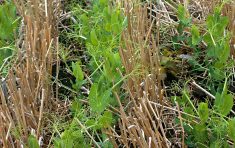Winnipeg | CNS Canada — India’s surprise move to impose 50 per cent tariffs on pea imports was a shock to Canadian exporters, but the tariffs were introduced to help India’s own farmers as the country works toward self-sufficiency in pulse production.
That’s according to Anurag Tulshan, director of pulse brokerage Esarco Exim Pvt. Ltd. and a member of the India Pulses and Grains Association (IPGA) executive committee.
Speaking here Tuesday at the Grain World conference, Tulshan said the 50 per cent tariff — the maximum allowable under World Trade Organization rules — was also a bit of a surprise to the Indian industry, as expectations had been for more modest 10-15 per cent tariffs.
Read Also

Farm groups’ response to new Trump tariffs muted
Farm groups’ response has been muted, thus far, in the face of U.S. President Donald Trump’s announced 35 per cent tariffs on Canadian goods. Goods under CUSMA are expected to continue to be exempted. Trump again brought up dairy tariff claims in justification for higher tariffs.
However, with a belief that Indian farmers were receiving a “raw deal” due to competition from cheaper imports, the government stepped in with the tariffs in an effort to support the domestic agriculture sector, he said, adding that the country aims to become self-sufficient in pulse production by 2022.
While any problems with India’s next crop could cause a change of heart from the government, Tulshan expected the tariffs would remain in place for the foreseeable future.
While India is a major purchaser of Canadian yellow peas, consumers in the country prefer pigeon peas and generally refer to yellow peas as “the poor man’s pigeon peas,” he said.
While tariffs on lentils are also being considered, Tulshan expected some pulse business would continue to take place, even with the tariffs.
Increased pulse acres in India would come at the expense of rice and wheat, he said.
As India is Canada’s largest market for pea exports, the new tariff “underscores the importance of continuing to diversify our markets,” said Carl Potts, executive director of Saskatchewan Pulse Growers, on the same Grain World panel.
While India had represented about 1.1 million tonnes of demand in recent years, he said, the Canadian pulse sector had a goal to grow total demand by three million tonnes by 2025.
With Indian demand declining, rising North American demand for vegetable protein is one of the major new demand fronts being explored. The current projects in development are expected to grow the domestic demand for peas by 750,000 tonnes over the next few years, said Marlene Boersch of Mercantile Consulting.
Roquette is one such company in the process of building a pea processing plant, at Portage la Prairie, Man. John Buch, Americas raw materials manager with the French company, was also on the panel and said the Portage plant should be online by 2019.
— Phil Franz-Warkentin writes for Commodity News Service Canada, a Glacier FarmMedia company specializing in grain and commodity market reporting. Follow him at @PhilFW on Twitter.




















